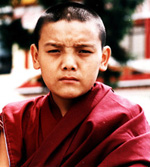
Brooklyn School for Music and Theatre
[Learning about the Himalayan Region through film]
| HOME |
| INTRODUCTION |
| LESSON 1 |
| LESSON 2 |
| LESSON 3 |
| LESSON 4 |
| LESSON 5 |
| LESSON 6 |
| LESSON 7 |
| LESSON 8 |
| FLASHCARDS |
| Geography Flashcards |

Film:Tsundu Becoming a Lama
Theme: Movement and Cultural Difussion
Instructional Objective: Students will be able to identify many ways in which Buddhist beliefs have affected Tsundu's life?
Central Question: How has Buddhism shaped Tsundu's Life?
Motivation: What are some decisions your parents have made that you do not agree with that have affected you?
Activity: Students will watch the film and answer the following questions?
1) Where is Tsundu living?
2) What decision did his parents make that affected his life?
3) What are some of the parts of Tsundu's daily routine?
4) How is his life different than many other children?
5) How often does Tusndu come home?
6) Why dont his parents want him to come home too often?
7) What shows how Tsundu feels about his life in the monastery?
8) What do his parents say about Tsundu's future?
9) What is Tusndu able to learn in the monastery that will help him in school?
Background information:
KOPAN MONASTERY
Kopan monastery is situated on a quiet little hill outside of Kathmandu city, the capital of the kingdom of Nepal. This monastery was established in 1970 by Lama Thubten Yeshe and Lama Thubten Zopa Rinpoche as a monastery for the monks and nuns of Solo Khumbu, an area on the foothills of the Himalaya mountains in the eastern part of Nepal. It is the homeland of Sherpas, an ethnic group who are Buddhists, but also famous for climbing high Himalayan peaks. Today Kopan, which is a Gelugpa monastery, is home to about 210 monks and 100 nuns who come from Nepal,
India and Tibet. Here they live and study Tibetan Buddhism. Tsundu is one of the monks in this monastery.
Kopan monastery is a part of the Foundation for the Preservation of the Mahayana Tradition (FPMT), an international network of some ninety centers dedicated to the study and practice of Buddhism. It has attracted many Westerners who visit Kopan every year to attend Buddhist teaching and meditation courses.
4. MONK SELECTION PROCESS
Kopan generally accepts children that are above 12 years of age as student monks. In Tibetan religious culture, parents traditionally
send their second son to become a monk. By becoming a monk, you not only acquire religious knowledge and religious merit, but life’s daily needs such as shelter and food are also provided by the monastery.
Usually parents bring their children to a particular monastery on the recommendation of friends, relatives and lamas. Tsundu’s parents first talked to Lama Lhundrup, the head abbot of Kopan, after Tsundu’s teacher at a secular Tibetan school recommended Kopan monastery. He was 10 years old at the time. After observing Tsundu to see if he had the potential to become a monk and after giving him some examinations, Lama Lhundrup asked his parents to bring Tsundu only the following year. When a new monk enters monastic life he is given a new name, symbolizing that he is no longer an ordinary person. Lama Lhundrup gave “Tsundu” as his monastic name.
5. TSUNDU’S FAMILY BACKGROUND
Tsundu’s parents and grandparents came to Nepal from Tibet as refugees more than 20 years ago. They live in a two-bedroom apartment near the holy Buddhist shrine Swayambhu in Kathmandu. Tsundu’s grandmothers from both of his parents sides live with his family. Both parents work for a Tibetan carpet factory. Tsundu has an older brother of 18
Assignment: Write an essay explaining how the ideas of the Buddhist religion have affected Tsundu's life